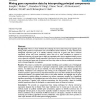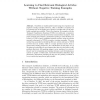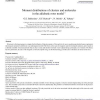688 search results - page 63 / 138 » Identifying Clusters from Positive Data |
BMCBI
2006
13 years 10 months ago
2006
Background: There are many methods for analyzing microarray data that group together genes having similar patterns of expression over all conditions tested. However, in many insta...
AUSAI
2008
Springer
14 years 4 hour ago
2008
Springer
Classifiers are traditionally learned using sets of positive and negative training examples. However, often a classifier is required, but for training only an incomplete set of pos...
TREC
2000
13 years 11 months ago
2000
There is a reservoir of knowledge in data from the TREC evaluations that analysis of precision and recall leaves untapped. This knowledge leads to better understanding of query ex...
CPHYSICS
2008
13 years 10 months ago
2008
We present a Fortran program to compute the distribution of dipole moments of free particles for use in analyzing molecular beams experiments that measure moments by deflection in...
ICGI
2010
Springer
13 years 11 months ago
2010
Springer
Angluin showed that the class of regular languages could be learned from a Minimally Adequate Teacher (mat) providing membership and equivalence queries. Clark and Eyraud (2007) sh...



